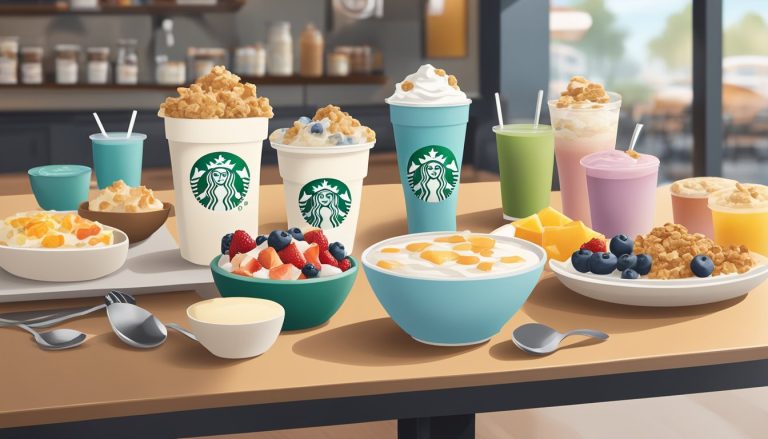Starbucks, the global coffee giant, has built a reputation not just for its beverages but also for its food offerings. Many customers wonder about the origins of these popular menu items, particularly the breakfast selections that pair so well with their morning coffee.
Starbucks sources its breakfast sandwiches and other food items from various suppliers and partners rather than producing them in-house. One key partner is Premium Brands Holding Corp, which has been working with Starbucks since 2010 to provide breakfast sandwiches. This outsourcing strategy allows Starbucks to focus on its core competency of coffee while still offering high-quality food options.
The company’s partnerships extend beyond just breakfast items. Starbucks collaborates with chefs and bakers worldwide to create a diverse menu that caters to different tastes and dietary needs. These carefully chosen suppliers must meet Starbucks’ rigorous standards to ensure consistency and quality across all locations.
Starbucks’ Commitment to Ethical Sourcing
Starbucks prioritizes ethical sourcing through comprehensive programs and partnerships. The company aims to ensure sustainable practices, support coffee farmers, and maintain high-quality standards throughout its supply chain.
C.A.F.E. Practices and Sustainable Coffee Growing
C.A.F.E. (Coffee and Farmer Equity) Practices is Starbucks’ cornerstone program for ethical coffee sourcing. It sets guidelines for sustainable farming methods, environmental protection, and fair labor practices.
Farmers implementing C.A.F.E. Practices focus on water conservation, soil management, and biodiversity preservation. These methods help maintain long-term crop health and productivity.
Starbucks provides training and resources to help farmers meet C.A.F.E. standards. This support includes agronomic assistance and access to financing for farm improvements.
Partnership Impact in Coffee-Belt Regions
Starbucks’ ethical sourcing efforts span major coffee-producing regions in Africa, Latin America, and Asia. The company works directly with farmers and local communities to address region-specific challenges.
In Latin America, Starbucks has established farmer support centers. These hubs offer technical assistance and training to improve coffee quality and yield.
African partnerships focus on women’s empowerment and youth engagement in coffee farming. Programs in Asia emphasize soil health and climate change resilience.
Starbucks invests in community development projects near its sourcing areas. These initiatives include building schools, health clinics, and clean water systems.
Verification Program and Third-Party Verification
Starbucks utilizes a rigorous verification process to ensure compliance with its ethical sourcing standards. This system involves both internal audits and third-party verification.
SCS Global Services oversees the approval of independent organizations that conduct supply chain inspections. These audits cover farms, processing facilities, and warehouses.
Inspectors evaluate performance against C.A.F.E. Practices criteria. They assess social responsibility, environmental impact, and product quality.
Suppliers must submit detailed applications outlining their entire coffee supply chain. This transparency allows for comprehensive evaluation and continuous improvement.
Strategic Breakfast Partnerships
Starbucks has forged key alliances with food suppliers to offer high-quality breakfast options. These partnerships allow the company to maintain consistent product standards while expanding its menu.
Collaboration with Premium Brands Holdings
Premium Brands Holdings Corporation has been a crucial Starbucks partner since 2010. This collaboration focuses on supplying breakfast sandwiches to Starbucks locations. Premium Brands produces over 80 million breakfast sandwiches annually for Starbucks, ensuring a steady supply of popular items like egg and cheese on English muffins.
The partnership leverages Premium Brands’ expertise in food manufacturing and Starbucks’ brand power. It allows Starbucks to offer fresh, made-to-order breakfast options without managing in-house food production. This arrangement helps maintain product consistency across thousands of stores.
Partnerships with Bakery and Sandwich Suppliers
Starbucks works with various bakery and sandwich suppliers to diversify its breakfast menu. SROriginals, a subsidiary of CSM Bakery Solutions, provides pastries and baked goods to Starbucks stores. This partnership ensures a steady supply of croissants, muffins, and other breakfast pastries.
For sandwich ingredients, Starbucks collaborates with regional suppliers. These partnerships allow for some menu customization based on local tastes and preferences. Starbucks also works with specialty producers for items like protein boxes and yogurt parfaits.
These strategic alliances enable Starbucks to offer a wide range of breakfast options while focusing on its core competency of coffee production and retail operations.
Starbucks’ Supply Chain Management
Starbucks employs sophisticated supply chain strategies to manage its global network of suppliers, distributors, and stores. The company focuses on efficiency, sustainability, and ethical sourcing practices.
Logistics and Distribution Strategies
Starbucks operates a complex logistics network to support over 50 million weekly transactions across its stores worldwide. The company maintains regional distribution centers strategically located to ensure timely delivery of products.
These centers use advanced inventory management systems to track stock levels and predict demand. This helps minimize waste and ensures fresh products are always available.
Starbucks also leverages technology to optimize transportation routes, reducing fuel consumption and costs. The company partners with third-party logistics providers to handle shipping and delivery to individual stores.
Supplier Diversity and Inclusion
Starbucks is committed to promoting diversity within its supply chain. The company actively seeks out and partners with minority-owned, women-owned, and veteran-owned businesses.
In 2020, Starbucks spent over $800 million with diverse suppliers. The company aims to increase this spending to $1.5 billion annually by 2030.
Starbucks provides mentorship and development programs to help diverse suppliers grow their businesses. This approach not only supports local communities but also enhances innovation and competitiveness in the supply chain.
Waste Reduction and Environmental Footprint
Starbucks has implemented various initiatives to reduce waste and minimize its environmental impact. The company has set ambitious goals to cut its carbon footprint and water use by 50% by 2030.
Efforts include:
- Transitioning to reusable or recyclable packaging
- Implementing composting programs in stores
- Reducing food waste through improved inventory management
- Investing in renewable energy for stores and roasting facilities
Starbucks is also working to eliminate single-use plastics, with plans to phase out plastic straws globally. The company encourages customers to use reusable cups and offers discounts for those who bring their own containers.
Product Development and Consumer Experience
Starbucks continuously evolves its product lineup and in-store atmosphere to meet changing consumer preferences. The company balances traditional offerings with innovative new items across beverages, food, and retail merchandise.
In-Store Offerings and the Starbucks Experience
Starbucks crafts a unique coffeehouse environment in its retail stores. Baristas prepare customized drinks using a variety of syrups and milk options, including Silk Soymilk. The food menu features pastries, sandwiches, and popular items like cake pops.
Stores showcase the brand’s signature green logo and warm wood tones. Comfortable seating areas encourage customers to linger and work. Many locations offer free Wi-Fi and mobile ordering for convenience.
Seasonal promotions and limited-time offerings keep the menu fresh. Holiday-themed cups and drinks generate excitement among loyal customers each year.
Expansion of Ready-To-Drink Products
Starbucks has significantly expanded its presence in grocery and convenience stores. The company’s line of bottled Frappuccinos and cold brews allows customers to enjoy Starbucks flavors at home or on-the-go.
Partnerships with PepsiCo and Nestlé have accelerated growth in this segment. These companies leverage their distribution networks to bring Starbucks products to a wider audience.
Ready-to-drink options now include nitrogen-infused cold brew, flavored lattes, and Doubleshot espresso drinks. Many feature the same ingredients used in Starbucks cafes, like their proprietary Fontana syrups.
Blending Tradition with Innovation: Teavana and More
Starbucks acquired Teavana in 2012 to strengthen its tea offerings. Teavana teas are now featured prominently in Starbucks stores alongside coffee drinks. Iced teas and tea lattes have become popular menu staples.
The company continues to innovate in the tea space. Starbucks has introduced sparkling tea drinks and bottled Teavana products for retail. These complement traditional hot tea preparations.
Beyond beverages, Starbucks experiments with food items tailored to local tastes. This is especially evident in the Asia Pacific region, where stores may offer unique pastries or savory snacks alongside global menu staples.
Starbucks’ Global Presence and Market Strategy

Starbucks has established a formidable international presence through strategic partnerships and cultural adaptation. The company’s expansion efforts have focused heavily on the Asia Pacific region while fostering meaningful connections with local communities worldwide.
Growth in the Asia Pacific Region
Starbucks has experienced rapid growth across Asia Pacific markets. China represents a key focus, with over 5,000 stores as of 2025. The company partnered with Alibaba to leverage e-commerce and expand its digital reach. In Japan, Starbucks operates over 1,600 locations. South Korea and Taiwan are also significant markets.
India emerged as a promising frontier through Starbucks’ joint venture with Tata Consumer Products. This partnership combines Starbucks’ coffee expertise with Tata’s local market knowledge. Store designs in India incorporate local art and architecture to resonate with customers.
Starbucks adapts its menu offerings to suit regional tastes. In China, stores offer red bean green tea frappuccinos. Japanese locations feature sakura-themed drinks during cherry blossom season.
Local Partnerships and Community Impact
Starbucks forms strategic alliances with local businesses and organizations in each market it enters. These partnerships help the company navigate regulatory environments and cultural nuances.
In Costa Rica, Starbucks works directly with coffee farmers to source high-quality beans while supporting sustainable agricultural practices. The company’s Farmer Support Centers provide resources and training to coffee growers globally.
Starbucks’ mission emphasizes creating a positive impact in communities it serves. Stores often become neighborhood gathering places. The company hires locally and invests in employee development programs.
In China, Starbucks partnered with the Forbidden City to open a culturally-inspired location. This blend of global brand and local heritage exemplifies Starbucks’ approach to international expansion.




